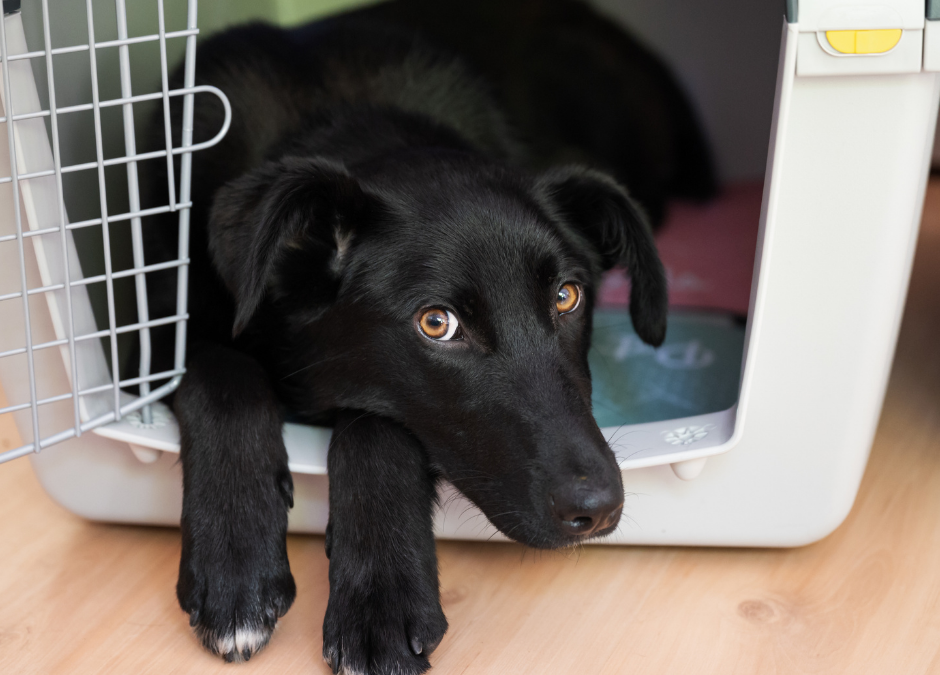Crates are a useful training tool and a great way to create a safe place for any dog. Making the crate a safe space helps protect your dog. And it provides a comfortable space for them. Like many aspects of training, the earlier you start, the easier it will be for all involved. For successful crate training, it’s important to make the crate a safe space for your dog by understanding the benefits, choosing the right crate, and using positive reinforcement during training.
Benefits of crate training
Some dog owners view crates as a negative space, but they shouldn’t be! Crates are an essential part of owning a dog. They provide a comforting and safe space for your pup. They also help keep your pup safe at home, in the car, and anywhere else you go. Even if you work from home and can be with your dog most of the day, there may come a time that you need to be able to crate them. Crate training them at a young age will reduce the stress of major life changes for both of you.
A properly introduced crate will become a safe space for your dog that they will go to when they are anxious, recovering from trauma or surgery, or uncertain about a situation. It’s a space that belongs just to them. They will grow to appreciate and use it when they need to.
Choosing the right size to make the crate a safe space
Choosing the right crate is an important part of making the crate a safe space for your dog. If starting out with a puppy, you will want a smaller crate. If the crate is too big, your puppy could use part of their crate as their sleeping space and part of it as a potty space. However, you may need to adjust the crate size as your dog grows. A general guideline is that your dog should be able to comfortably stand up and turn around in their crate. If they can’t, it’s time for a larger size. If you aren’t sure what size your dog needs, the Association of Professional Dog Trainers has a helpful chart that breaks down size, weight, and breed.
Once you have the right crate size, try to make it as comfortable as possible. You may want to purchase a crate pad along with your crate if your pup prefers softer spaces. You can use old sheets or towels to help pad the floor of the crate. A favorite toy might help your dog feel more comfortable as well. If your dog is prone to tearing things up, skip the padding and the toys so there’s no risk of ingesting them when unattended.
Positive reinforcement during crate training
When you first purchase a crate, bring it into the house and let your pup get used to seeing and smelling it. Encourage them to explore it and remain positive if they don’t want to go in right away. When they do go in the crate, talk to them in a positive and upbeat tone of voice and give them a few treats. This will help them associate the crate with a positive, happy space. Be sure your dog has access to their crate during the day so they can explore it whenever they want.
As your dog starts to get comfortable with their crate, incorporate one of their favorite things: mealtime. Start by placing their food bowl near the crate during meals. Slowly move it closer and eventually inside the crate as they become more comfortable with it. Once comfortable eating inside the crate, you can begin closing the door of the crate while they’re eating.
When crating your dog, start with short lengths of time and lots of positive reinforcement. Slowly increase the time they are crated. Crating your dog for too long right away can create stress and result in a negative association with the crate. While there may be times you crate your dog due to bad behavior, it’s always best to crate them with positive reinforcement before bad behavior can occur. For example, if visitors are coming over and you want to avoid your dog jumping and barking, crate them with a treat and a toy before your guests arrive instead of crating them as punishment after they jump.
Help with crate training
As you work to make the crate a safe space for your dog, the most important thing to remember is to work at their pace, stay positive, and be consistent. If you need help with crate training, reach out to us for more information about our dog training services.

